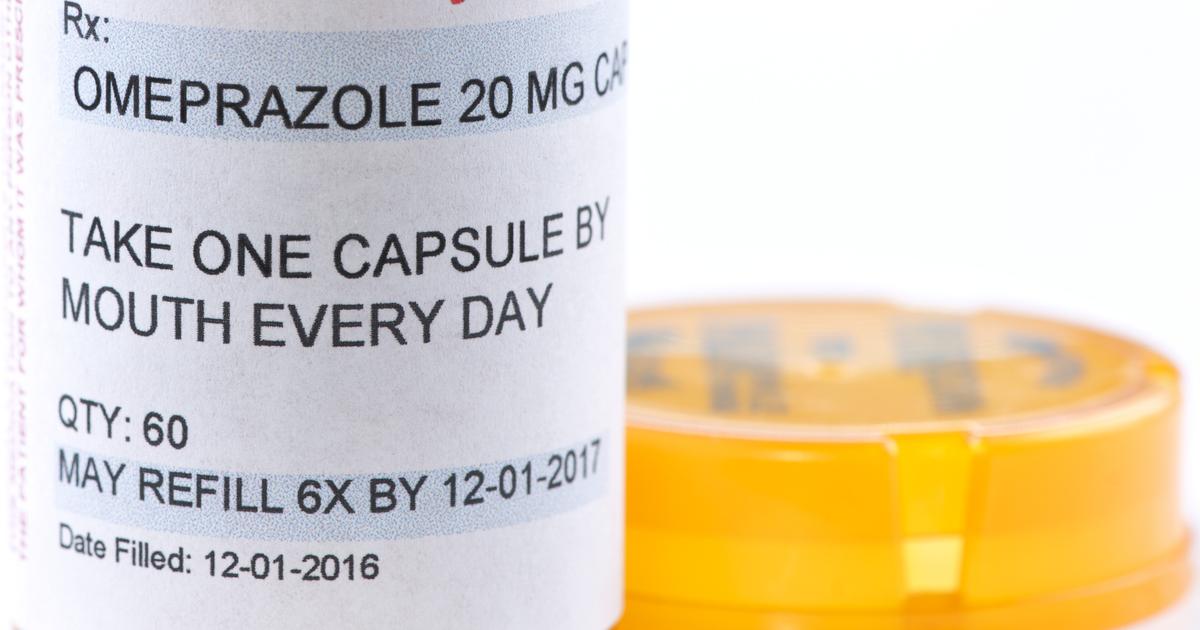Unexpected Facts About Omeprazole That Will Blow Your Mind
Omeprazole is one of the most widely used medications for treating acid-related conditions, but there’s more to it than meets the eye. As a proton pump inhibitor (PPI), it works by reducing the amount of acid produced in the stomach, making it a go-to treatment for conditions like acid reflux, GERD, and peptic ulcers. While many people know it as an over-the-counter heartburn remedy, this little pill has a surprising history, fascinating mechanisms, and some unexpected side effects that most users are unaware of. We’ve expanded our list to 20 mind-blowing facts about omeprazole, covering everything from its unusual origins and hidden benefits to its lesser-known risks and rare side effects. Whether you're a regular user, a healthcare professional, or just curious about how this drug works, these unexpected insights might change the way you think about omeprazole. Let’s dive in!
1. How It Works

As a proton pump inhibitor, omeprazole works by suppressing the secretion of stomach acid. It blocks the action of the proton pump, an enzyme system located on the surface of the gastric parietal cells. Omeprazole blocks the last step in the process of stomach acid production, and it starts to work within one hour after it is taken by mouth. The full effect of the medicine is normally felt within two hours, and omeprazole can continue to inhibit stomach acid secretion for up to three days after a single dose. Once omeprazole is discontinued, the patient's stomach acid levels will return to their baseline after three to five days.
2. Uses For Omeprazole

Prescription omeprazole is used to treat gastroesophageal reflux disease, gastric and duodenal ulcers, and stomach infections caused by the H. pylori bacteria. The medication can also be used to treat Zollinger-Ellison syndrome and erosive esophagitis, a condition in which there is acid-related damage to the esophagus (the tube that connects the mouth to the stomach). The over-the-counter version of omeprazole is used to treat heartburn that occurs at least two days a week in adults. It should not be taken for more than fourteen days without consulting a doctor, and it is not intended for the immediate relief of heartburn. Prescription omeprazole can be given to children who are at least twelve months old, and patients who use this form of the medicine should continue to take it even if they feel well; patients will need to talk with a doctor before stopping the prescription.
3. Side Effects Of Omeprazole

Adults who use omeprazole could experience headaches, nausea, vomiting, abdominal pain, and gas. Children taking this medicine might develop a fever in addition to these side effects. Omeprazole may also cause more serious side effects for some patients. For example, blood tests could show low magnesium, especially if the patient has taken omeprazole for more than three months. Potential symptoms of reduced magnesium include seizures, fast heartbeat, spasms of the hands and feet, muscle weakness, and dizziness. Using omeprazole for more than three years might lead to a vitamin B12 deficiency too. Patients with this nutritional deficiency typically experience signs such as numbness in the hands and feet, poor muscle coordination, menstrual changes, and nervousness. This medication could also cause kidney damage, and patients with this side effect often have urinary changes and pain in the side and back.
Individuals who use omeprazole have a higher risk of wrist, hip, and spine fractures, and the medication could lead to severe diarrhea and inflammation of the stomach lining. Patients with an inflamed stomach lining usually report symptoms such as weight loss, stomach pain, and vomiting. The medication has been associated with the development of systemic lupus erythematosus, and this might trigger blood clots, weight loss, fever, fatigue, and heartburn. Some patients taking omeprazole develop cutaneous lupus erythematosus, which leads to the formation of a red, raised, and scaly rash on the body. The rash can sometimes be purple, and it may also form on the nose.
4. Precautions To Remember

Before using prescription omeprazole, patients should inform their healthcare team about all medications they take, including St. John's wort, anticoagulants, and diuretics. The physician may need to adjust the patient's dose of these medicines if omeprazole is added, and they might also recommend frequent follow-up appointments for monitoring. Patients who take rilpivirine are typically advised not to use omeprazole. Since the proton pump omeprazole inhibits is stimulated by food, patients need to take this medicine on an empty stomach, and ideally with a full glass of water. It is safe for patients to continue their normal diet while taking omeprazole. If a dose is missed, the patient should take the missed dose as soon as they remember. However, if it is only a few hours before the next scheduled dose, the missed dose should be skipped. Taking two doses at once could increase the risk of side effects. Patients who use nonprescription omeprazole should let their doctor know if they have experienced heartburn for more than three months and if they have symptoms such as chest pain, shortness of breath, difficult or painful swallowing. These symptoms might be signs of a more serious medical problem that cannot be treated with nonprescription omeprazole. In addition, patients should let their doctor know if they have ever had a vitamin B12 deficiency, low magnesium levels, or liver disease.
5. Potential Medication Interactions

Omeprazole reduces the effectiveness of nelfinavir, atazanavir, and rilpivirine, and it should not be taken with any of these medicines. Omeprazole also reduces the effectiveness of clopidogrel, and this could lead to blood clots, so patients who take clopidogrel should not take omeprazole. Individuals who take high doses of voriconazole might need a lower dose of omeprazole to avoid side effects, and omeprazole significantly increases the amounts of warfarin, digoxin, saquinavir, and tacrolimus in the body. Patients may have their doses of these medicines lowered while they are taking omeprazole. Antibiotics such as ampicillin may not be as readily absorbed by the body while patients are taking omeprazole, and omeprazole also interferes with the body's ability to absorb iron-containing products. Patients using erlotinib as part of their cancer treatment should speak to their healthcare team; omeprazole can interfere with the effectiveness of this treatment.
6. Commonly Prescribed Alternatives

Patients who cannot use omeprazole may be prescribed esomeprazole, pantoprazole, ranitidine, or famotidine. Other commonly prescribed alternatives include simethicone, calcium carbonate, and magnesium hydroxide. Some of these alternatives are available over-the-counter, and stronger doses of the same medicines may be prescribed by a physician. Some doctors may suggest lansoprazole as an alternative medication for omeprazole as well. Patients should tell their doctor about all over-the-counter medicines and prescriptions they take, and the physician also needs to know about all vitamins, minerals, and supplements the patient uses. When discussing the need for alternative medications, the patient should mention any known allergies to medicines and any side effects experienced while taking omeprazole.
7. Dosage Factors

Proper dosages of omeprazole vary depending on the patient's age, overall health, and the condition for which omeprazole is being used. Adults with duodenal ulcers will normally be prescribed twenty milligrams each day for four weeks, and the adult dosage for treatment of a Helicobacter pylori infection is forty milligrams per day for fourteen days. Patients who use omeprazole for the treatment of this infection will usually take the omeprazole together with clarithromycin. Adults who have erosive esophagitis generally take twenty milligrams of omeprazole each day for four to eight weeks. Pediatric patients with this condition are dosed based on weight. Patients between one and sixteen years old who weigh between ten to 19.9 kilograms should take ten milligrams of omeprazole each day for four to eight weeks. Pediatric patients who weigh at least twenty kilograms can take the standard adult dosage of twenty milligrams per day. Individuals who have liver issues are advised to take only ten milligrams per day as a maintenance dose for healing from erosive esophagitis, and patients with kidney conditions can take the standard adult dose.
8. Who Shouldn't Take It

Patients who are allergic to esomeprazole, lansoprazole, pantoprazole, or rabeprazole should not use omeprazole. The medication may not be safe for use by patients with liver disease, osteoporosis, or osteopenia. Individuals who use HIV medications containing rilpivirine should not take omeprazole, and the medicine should be used with caution in patients who have a history of difficulty swallowing. Patients should ask their healthcare provider or pharmacist before purchasing over-the-counter omeprazole if they have stomach pain, nausea, vomiting, frequent chest pain, wheezing, or unexplained weight loss. Individuals who know they have low magnesium should also ask a physician before taking this medication, and medical advice should be obtained before using omeprazole if heartburn has continued for more than three months. Omeprazole should not be given to children unless a doctor has been consulted. Additionally, patients who have noticed unexplained weight loss or blood in their stools should check with a clinician before taking this medication.
9. Tips For Taking It

Omeprazole typically needs to be taken at least one hour before eating, and patients should check the leaflet that comes with their medication for advice on medication timing. When using the oral suspension (liquid) version of this medicine, the patient should shake the bottle before dispensing the dose. The provided dosing syringe should be used to measure the appropriate dose; a kitchen spoon is not accurate. Patients who use the capsule form of omeprazole must swallow the whole capsule. Those who cannot do so may open the capsule and place the contents in a spoonful of applesauce. The applesauce must then be consumed immediately. Omeprazole comes in a powdered form, and this needs to be dissolved in a tiny amount of water. Patients should drink the water immediately, and individuals who use a nasogastric tube can take it with a catheter-tipped syringe. When over-the-counter omeprazole is used, this must be taken for no more than fourteen days. Patients can expect their symptoms to improve within one to four days. After using over-the-counter omeprazole for fourteen days, the patient needs to wait at least four months before starting a new fourteen-day course of over-the-counter omeprazole. Omeprazole could affect certain laboratory tests, and patients should let all of their healthcare providers know they are taking this medicine. Omeprazole should be stored at room temperature, and it needs to be kept away from heat and moisture.
10. Symptoms Of Omeprazole Overload

Patients who take too much omeprazole could develop symptoms of omeprazole overload. For example, the patient may feel nauseous, and vomiting could occur. Vision could become blurry, and the patient might begin to sweat profusely. They could feel very drowsy and confused, and a rapid heartbeat may be present as well. The symptoms of omeprazole overload will depend on how much of the medication the patient has taken and on whether it was consumed with alcohol or with any other medicines. Patients who exhibit these symptoms should be taken to an emergency room for evaluation. Doctors at the emergency room will need to know how much omeprazole the patient took, when the overdose occurred, and whether alcohol, recreational drugs, or medicines were taken along with the omeprazole. The patient will be placed on a cardiac monitor, and their vital signs will be checked regularly. Treatment generally involves treating the symptoms that occur as a result of the overload. Patients will be given supportive care that could include breathing assistance, anti-nausea medicines, and fluids.
11. It Was Discovered by Accident

Omeprazole's discovery was a happy accident rather than a planned breakthrough. In the 1970s, researchers at the Swedish pharmaceutical company Astra AB (now part of AstraZeneca) were on a mission to develop new ulcer medications. Their goal was to create a drug that could protect the stomach lining without completely halting acid production. However, they stumbled upon something unexpected—omeprazole had the unique ability to shut down stomach acid production almost entirely, far more effectively than any medication before it. The discovery was a game-changer, revolutionizing the way acid-related conditions like ulcers, GERD, and acid reflux were treated. Before omeprazole, treatment options were limited to antacids and H2 blockers, which provided only temporary relief. By completely blocking the stomach's proton pumps, omeprazole paved the way for a new generation of acid-suppressing medications, turning it into one of the most widely used drugs worldwide.
12. It Can Alter Your Gut Bacteria

While omeprazole is highly effective at reducing stomach acid, it can also disrupt the delicate balance of gut bacteria, sometimes leading to unexpected digestive issues. Stomach acid acts as a natural barrier, killing off harmful bacteria before they can colonize the intestines. However, when acid levels are suppressed for extended periods, certain bacteria—both good and bad—can start to thrive in ways they wouldn’t normally. One of the most concerning side effects is an increased risk of Clostridium difficile (C. diff) infections, a harmful bacterial overgrowth that can cause severe diarrhea, abdominal pain, and inflammation of the colon. Studies have shown that long-term PPI use can significantly alter the gut microbiome, reducing the population of beneficial bacteria while allowing harmful strains to flourish. This imbalance can lead to bloating, digestive discomfort, and a weakened immune response. For those taking omeprazole long-term, probiotic supplements or fermented foods may help maintain a healthier gut balance and prevent some of these issues.
13. It Might Cause ‘Rebound Acid Hypersecretion’

Stopping omeprazole cold turkey can sometimes make acid reflux and heartburn worse than before. This phenomenon, known as rebound acid hypersecretion, occurs when the stomach suddenly ramps up acid production to compensate for the suppression caused by omeprazole. As a result, patients may experience severe heartburn, bloating, nausea, and indigestion—even if they never had significant symptoms before. This happens because omeprazole shuts down the stomach's proton pumps, and when the medication is stopped suddenly, these pumps become overactive, producing more acid than normal. Studies suggest that even after just four to eight weeks of use, the stomach may take several weeks to recalibrate and return to normal acid production. Doctors often recommend gradually tapering off PPIs rather than stopping abruptly. This might involve lowering the dose, switching to an H2 blocker, or using antacids as needed while the stomach adjusts. For long-term users, consulting a doctor before stopping omeprazole is always a wise approach.
14. It Could Affect Nutrient Absorption

One of the lesser-known effects of long-term omeprazole use is that it can interfere with the absorption of key vitamins and minerals, potentially leading to deficiencies. Stomach acid plays a crucial role in breaking down calcium, magnesium, iron, and vitamin B12, making them easier for the body to absorb. When acid levels are significantly reduced, these nutrients don’t get properly extracted from food, increasing the risk of deficiencies. Vitamin B12 deficiency is particularly concerning, as it can cause fatigue, nerve damage, memory problems, and even depression. Low magnesium levels can result in muscle cramps, irregular heart rhythms, and weakness, while poor calcium absorption may contribute to osteoporosis and a higher risk of fractures. For individuals taking omeprazole long-term, regular blood tests to monitor nutrient levels are a good precaution. Doctors may also recommend supplements or dietary changes to compensate for the reduced absorption.
15. It May Influence Mental Health

There’s growing evidence that omeprazole and other PPIs might be linked to mental health changes, including increased risk of depression, anxiety, and cognitive issues. While the connection isn’t fully understood, researchers believe there are a few possible explanations. First, omeprazole's effect on nutrient absorption may play a role. Vitamin B12 deficiency, which can occur with prolonged PPI use, has been directly linked to mood disorders, memory loss, and cognitive decline. Additionally, magnesium deficiency—another side effect of PPIs—has been associated with increased stress and anxiety symptoms. Another theory suggests that omeprazole could affect neurotransmitter activity by altering the gut microbiome. Since the gut and brain are closely connected, changes in digestive bacteria could influence serotonin levels, which are crucial for mood regulation. While more research is needed, individuals who experience unexplained mood changes while on omeprazole may want to consult their doctor about alternative treatments.
16. It’s One of the Most Overused Medications

Omeprazole is often prescribed for longer than necessary, despite recommendations that it should be used short-term for most conditions. Many people end up taking it for years without realizing the risks associated with prolonged use. Studies have found that 30–50% of people taking PPIs long-term may not actually need them. Many patients continue using them without doctor supervision, sometimes as a habit or because they fear their symptoms will return. This overuse increases the risk of nutrient deficiencies, kidney disease, and rebound acid production. Doctors recommend regular check-ins for patients on omeprazole, and in many cases, lifestyle changes, dietary adjustments, or alternative medications may be safer options.
17. It Might Be Linked to Kidney Disease

Recent research has raised concerns about a potential link between long-term omeprazole use and chronic kidney disease (CKD). While the exact mechanism is unclear, some studies suggest that PPIs may cause gradual kidney damage over time. One theory is that PPIs like omeprazole may trigger low-level inflammation in the kidneys, which, over time, reduces kidney function. Additionally, omeprazole has been linked to acute interstitial nephritis, an inflammatory condition that can cause sudden kidney problems. For individuals with existing kidney conditions, doctors often recommend avoiding long-term PPI use and exploring alternative treatments.
18. It Can Interact with Food Timing

Many people don’t realize that when you take omeprazole can significantly impact how well it works. The medication is most effective when taken 30–60 minutes before a meal, because food triggers stomach acid production. Taking it on a full stomach delays its activation, reducing its effectiveness. Doctors advise taking omeprazole first thing in the morning before breakfast for optimal results. If a second daily dose is required, it should be taken before dinner, not before bed, since acid production slows down overnight.
19. It’s on the World Health Organization’s List of Essential Medicines

Despite its potential risks, omeprazole is considered one of the most important medications in the world. It is listed on the World Health Organization’s (WHO) Model List of Essential Medicines, which highlights critical drugs needed for a functioning healthcare system. This recognition underscores omeprazole’s importance in treating acid-related conditions globally, particularly in countries where severe ulcers and acid reflux are widespread.
20. It Has an Unusual Connection to Helicobacter Pylori

Omeprazole isn’t just used to treat acid reflux—it also plays a key role in eradicating H. pylori infections, which are a major cause of stomach ulcers. When combined with antibiotics, omeprazole suppresses acid production, making it easier for the antibiotics to kill the bacteria. Interestingly, H. pylori infections can also alter stomach acid production over time, sometimes leading to acid reflux or ulcers even after the infection is gone. This makes omeprazole’s role in treatment even more significant.
The Hidden Depths of Omeprazole: More Than Just Heartburn Relief

Omeprazole is far more than just a quick fix for heartburn—its effects on the body extend into areas that most people never consider. From its accidental discovery to its unexpected links to kidney health, gut bacteria, and mental well-being, this widely used medication has a fascinating and sometimes surprising profile. While it remains a lifesaving drug for acid-related conditions, long-term use comes with potential risks, making doctor supervision and informed decision-making essential. Whether you’re a regular user, considering omeprazole for the first time, or just curious about how it works, understanding its hidden effects can empower you to make better health choices. With proper timing, dosage, and awareness of possible side effects, omeprazole can be a powerful tool for relief. But as with any medication, knowledge is key—and now you have 20 surprising facts to make the most informed decision possible.
